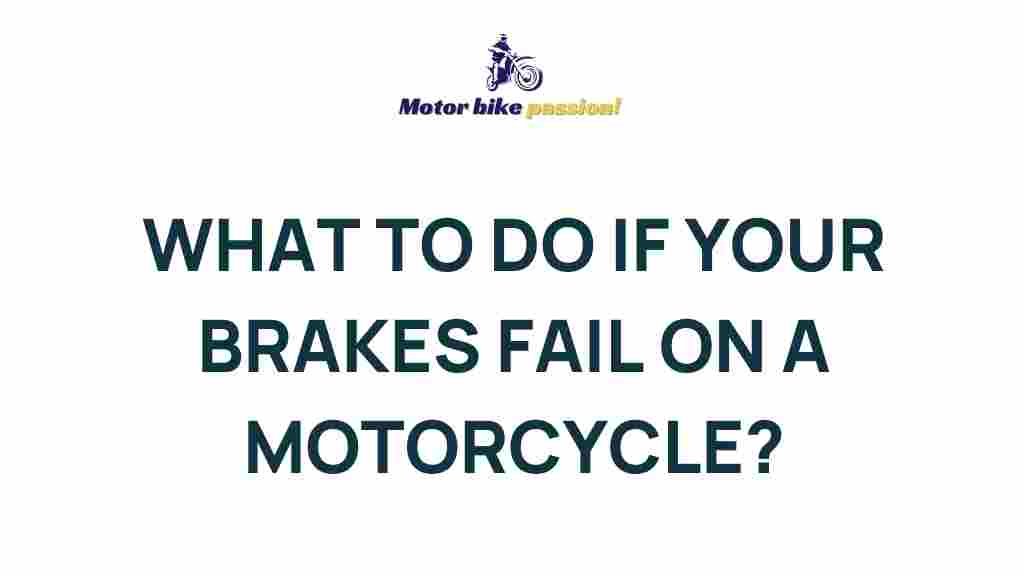Expert Tips for Handling Motorcycle Brake Failures
Motorcycle enthusiasts understand the thrill of riding, but with that thrill comes a significant responsibility: ensuring safety on the road. One of the most critical components of any motorcycle is its braking system. A brake failure can lead to catastrophic consequences, making it essential for riders to know how to handle such emergencies. In this article, we provide expert tips and advice for managing motorcycle brake failures effectively, ensuring your safety and the safety of others on the road.
Understanding Brake Failure
Before diving into handling techniques, it’s important to understand what constitutes a brake failure. Brake failure can occur due to various reasons, including:
- Worn brake pads: Over time, brake pads wear down and may no longer provide adequate stopping power.
- Fluid leaks: Brake fluid is essential for hydraulic brake systems; leaks can lead to brake failure.
- Overheating: Continuous use of brakes can cause them to overheat, reducing their effectiveness.
- Mechanical failure: Issues with brake calipers, rotors, or master cylinders can lead to brake failure.
Recognizing the early signs of brake issues can prevent brake failure. Always pay attention to changes in your motorcycle’s braking performance.
Step-by-Step Process for Handling Brake Failure
In the event of a brake failure while riding, follow these expert tips to manage the situation safely:
1. Stay Calm
The first step in handling a brake failure is to remain calm. Panic can cloud your judgment and lead to poor decision-making. Take a deep breath and focus on the actions you need to take.
2. Assess Your Situation
Evaluate your surroundings and determine the best course of action. Consider the following:
- Speed: How fast are you going?
- Traffic: What is the flow of traffic around you?
- Road conditions: Are there any obstacles or hazards ahead?
3. Use Engine Braking
When you realize that your brakes are failing, the first method to slow down is to utilize engine braking. Here’s how:
- Shift down through the gears to lower your speed.
- Throttle down gently to decrease your speed without losing control.
4. Maintain Control
As you slow down, keep both hands on the handlebars and your body relaxed. Avoid sudden movements that could destabilize your motorcycle. Lean your body slightly forward to help with balance.
5. Look for an Escape Route
Your goal is to find a safe place to stop. Look for:
- Open spaces without traffic.
- Soft ground or grass to reduce impact.
- Gradients that can help slow you down naturally.
6. Use Your Horn and Lights
Alert other road users to your situation by using your horn and flashing your lights. This can help ensure that vehicles around you are aware you are experiencing a problem.
7. Use the Kill Switch if Necessary
If you cannot slow down effectively, consider using the kill switch to turn off the engine. This can help reduce the motorcycle’s speed but should be a last resort, as it may also lead to loss of control.
Troubleshooting Brake Issues
Once you’ve safely handled a brake failure situation, it’s essential to troubleshoot the brake system to prevent future occurrences. Here are some tips:
1. Regular Maintenance Checks
Make it a habit to perform regular maintenance checks on your motorcycle. This includes:
- Checking brake pads for wear.
- Inspecting brake fluid levels and looking for leaks.
- Testing the responsiveness of your brakes.
2. Replace Worn Components
If you find any worn or damaged parts, replace them immediately. Always use high-quality parts that are compatible with your motorcycle.
3. Check Brake Fluid
Ensure that your brake fluid is at the appropriate level and is not contaminated. If you notice a significant drop in fluid levels, it could indicate a leak.
4. Consult a Professional
If you’re unsure about the condition of your brakes, don’t hesitate to consult a professional mechanic. Regular servicing by an expert can ensure that your motorcycle remains in top condition.
Conclusion
Handling motorcycle brake failures can be daunting, but with the right knowledge and preparation, you can manage such emergencies effectively. Remember to stay calm, utilize engine braking, and always be on the lookout for an escape route. Regular maintenance is key to preventing brake failure in the first place. For more information on motorcycle safety and maintenance, check out this resource.
By following these expert tips, you’ll not only ensure your safety but also enhance your riding experience. Always prioritize safety and be proactive in maintaining your motorcycle’s braking system.
For further reading on motorcycle safety tips, visit this link.
This article is in the category Safe Driving and created by MotorBikePassion Team
